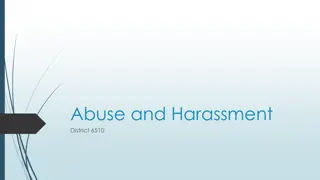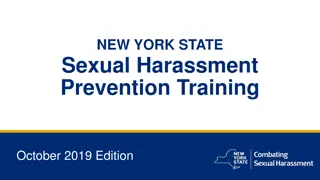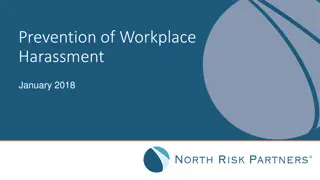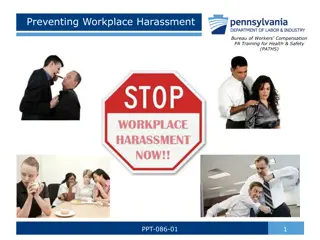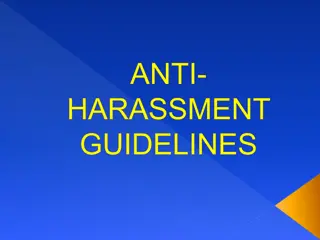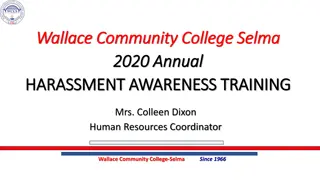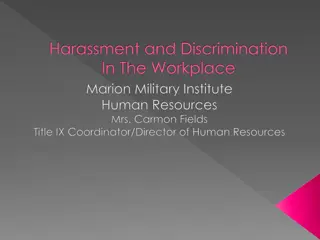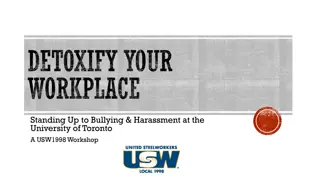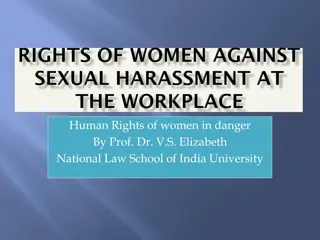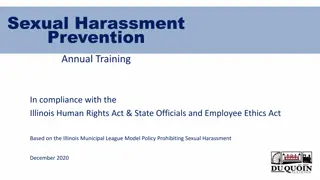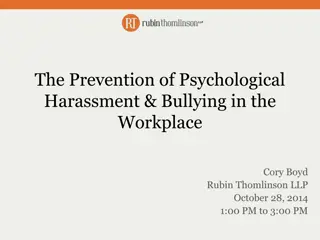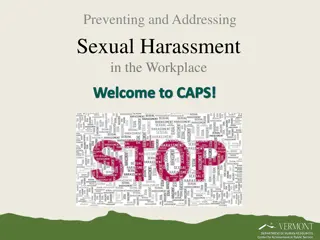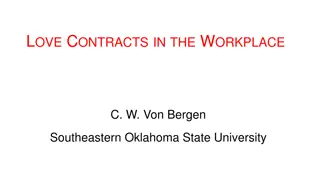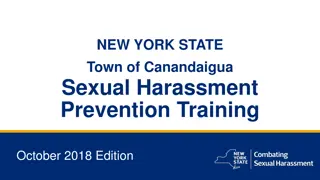Strategies for Reducing Workplace Harassment: Key Questions for Employers
Employers can take proactive steps to reduce workplace harassment by implementing effective policies, conducting training, and asking critical questions to cultivate a healthy work environment. Understanding unlawful harassment, elements of a claim, factors to consider, and examples of misconduct are essential in addressing this important issue. By prioritizing integrity in policies and promoting meaningful training, employers can create a culture of respect and inclusion.
- Workplace harassment
- Employer strategies
- Unlawful discrimination
- Healthy work environment
- Training effectiveness
Download Presentation

Please find below an Image/Link to download the presentation.
The content on the website is provided AS IS for your information and personal use only. It may not be sold, licensed, or shared on other websites without obtaining consent from the author. Download presentation by click this link. If you encounter any issues during the download, it is possible that the publisher has removed the file from their server.
E N D
Presentation Transcript
How to Reduce Harassment in the Workplace? Questions Employers Should Pose Tim K. Garrett
How Can an Employer Reduce Workplace Harassment? Prevalent Question in Culture #Metoo #Timesup But has been a recognized claim since 1986 Savvy employers know: Must have policy prohibiting unlawful harassment - Publicized - With effective complaint procedure Should conduct training - Managers - At least train those charged with enforcement But, Studies show that policy + training not effective Why? Today s Presentation Practical Guidance Three questions employers should ask in trying to cultivate a healthy workplace environment
Refresher What is unlawful harassment? A form of unlawful discrimination, meaning some differing treatment based upon protected characteristic The differing treatment creates a hostile work environment based upon that protected characteristic Unwelcome and severe or pervasive conduct Directed toward another based on that persons protected status - Race, sex, religion, age, disability, etc. - Including the employee s protected activity
Elements of Claim Victim member of protected class (expansive reading in today s culture) Harassment based on protected class Harassment unwelcome and severe or pervasive (objectively and subjectively) Special elements depending on job title of alleged harasser If manager and if tangible job action no defense If manager and hostile environment defense If co-worker employee has to prove negligence
Factors Considered Is conduct verbal or physical or both? Frequency of conduct single incident or pattern? Patently offensive or ambiguous ? Co-worker or manager?
Examples Leering Shoulder massage or suggestive touching/hugging Leaning over getting in personal space in offensive manner Inappropriate jokes Taking about personal sex life
Questions to Ask Do employees perceive the anti-harassment policy has integrity? Do employees perceive the training as merely litigation risk avoidance, or as an attempt at properly cultivating a healthy workplace? Do employees perceive commitment at the top ?
Do Employees Perceive the Policy Has integrity? This is revealed in the small details, not the big complaints. Do management s actions inform employees that management cares about their concerns? Or, are seemingly minor complaints dismissed as unimportant In life we learn the seemingly little things become the big things Seat-belt story Enforcement must balance the interests of various constituencies Victim Alleged harasser Other employees Process itself Balance under-reacting (management does not care) and over- reacting (complaints potentially can become misused) Example what do you do with anonymous complaint?
Training Merely Litigation Risk Avoidance? Is training for information or for transformation? Information Here are the rules and policies Don t do that No wonder training not effective Worse here are the rules, obey or we get sued (or you get fired) Fear-based only (parent example) Compliance suffers message could be heard cover it up Message also Company cares only about its risk, not about its employees Not a healthy narrative Most valuable asset policy Transformation What are the reasons for the rules? What are the purposes behind policies? Can our management team articulate those deeper purposes?
Training Merely Litigation Risk Avoidance? (contd) Barney Fife or Andy Taylor?
Training Merely Litigation Risk Avoidance? (contd) Barney Fife or Andy Taylor? Rules are primary (Barney) Relationships are primary (Andy) What relationships do the rules really serve? Analysis can be scary but also transforming Leads to a more fundamental question: What is our work really for? Is my work only for me? If Company message is do this for Company s bottom line, then such selfish view is promoted, not rebutted. Can we have a workplace that recovers the idea that human work is not merely a job but a calling Not merely about my own advancement but also about the good of the community in which I serve Leads to strong other-mindedness in our work Dr. Martin Luther King, Jr.: Life s most urgent and persistent question is What are you doing for others?
Do my employees perceive this tone at the top ? This transformation process can only be accomplished if there is commitment from the very top of the organization. Drug testing policy example Each individual is the greatest contributor to the type of workplace she would want to work in And the most influential Those considered leaders will have greatest impact on cultivating this type of community But only if actions reinforce the ideals. I cannot hear what you are saying because your actions speak so loudly.
Questions to Ask To Cultivate Healthy Workplace - Recap Do employees perceive the anti-harassment policy has integrity? (Do we show we care?) Do employees perceive the training as merely litigation risk avoidance, or as an attempt at properly cultivating a healthy workplace? (Is our care other-minded or team-oriented ?) Do employees perceive commitment at the top ? (Do our actions as managers/leaders conform to our professed ideals?)
Thanks! Questions?
Tim K. Garrett (615) 742-6270 tgarrett@bassberry.com





